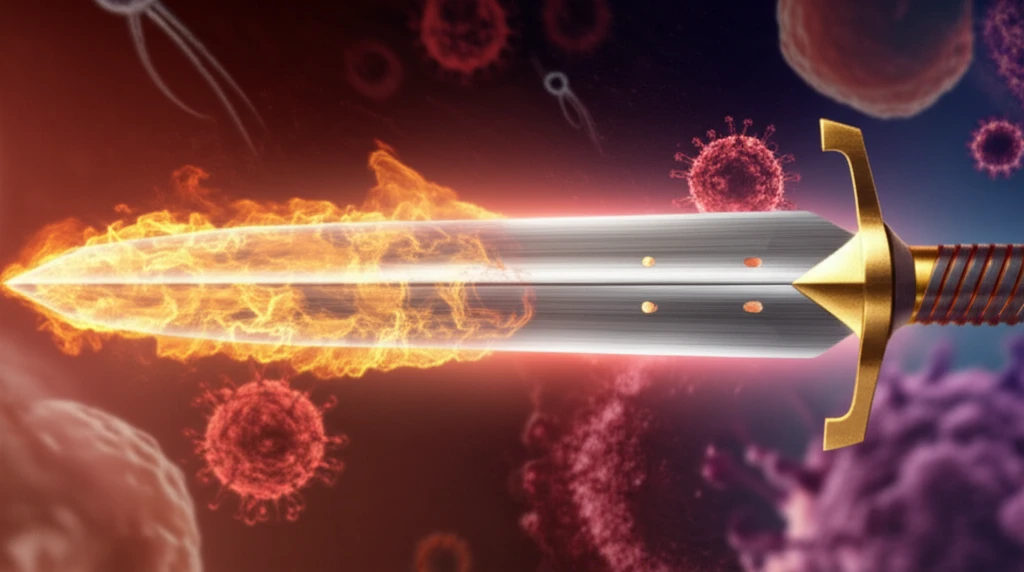
IL-15: The Double-Edged Sword in Cancer
"How this powerful immune cytokine can both fuel and fight tumors, and what that means for future therapies."
Interleukin-15 (IL-15) is a cytokine, a type of signaling molecule that plays a crucial role in the immune system. It belongs to the IL-2 family, a group of cytokines known for their ability to stimulate the growth, survival, and activity of immune cells like NK cells, T cells, and B cells. These cells are essential for fighting off infections and diseases, including cancer.
However, the story of IL-15 is more complex than it seems. While it can boost the immune system's ability to attack tumors, IL-15 has also been shown to support the growth and survival of certain types of cancer cells. This duality makes IL-15 a fascinating and challenging target for cancer research and therapy.
This article dives into the conflicting roles of IL-15 in cancer, exploring how it can act as both a friend and foe. We'll examine the mechanisms behind its actions, the potential benefits and risks of targeting IL-15 in cancer treatment, and the exciting new strategies being developed to harness its power for good.
IL-15: Fueling the Fire or Lighting the Way?

IL-15 exerts its effects by binding to a receptor complex on the surface of immune cells. This complex includes the IL-15 receptor alpha chain (IL-15Ra), IL-2/IL-15Rβ (CD122), and the common gamma chain (γc or CD132). The binding of IL-15 to this receptor triggers a cascade of events inside the cell, activating signaling pathways like JAK/STAT, which promote cell survival, proliferation, and function.
- Pro-Tumor Effects: In certain lymphoid malignancies, such as large granular lymphocyte leukemia (LGLL), B-chronic lymphocytic leukemia (B-CLL), and adult T-cell leukemia (ATL), IL-15 can act as a growth factor, supporting the survival and proliferation of cancer cells. This can happen through autocrine signaling (where the cancer cell produces its own IL-15) or paracrine signaling (where IL-15 is produced by other cells in the tumor microenvironment).
- Anti-Tumor Activities: Conversely, IL-15 is a potent activator of NK cells and T cells, which are key players in the immune system's fight against cancer. IL-15 can enhance the cytotoxic activity of these cells, enabling them to directly kill tumor cells. It also promotes the production of other cytokines, such as IFN-γ and TNF-α, which further stimulate the immune response.
- IL-15 Trans-presentation: IL-15 action is also regulated by "trans-presentation", in which IL-15 bound to IL-15Ra on one cell (typically a dendritic cell) is presented to another cell expressing the IL-2/IL-15Rβ/γc complex. This mechanism is crucial for NK cell development and activation.
The Future of IL-15 in Cancer Therapy: A Balancing Act
Given the dual nature of IL-15, researchers are exploring various strategies to harness its anti-tumor potential while minimizing its pro-tumor effects. One approach is to use IL-15 superagonists, which are modified forms of IL-15 that exhibit enhanced activity and selectivity for immune cells. These superagonists can boost the immune response against cancer without directly stimulating tumor cell growth.
Another strategy is to combine IL-15 with other immunotherapeutic agents, such as checkpoint inhibitors or adoptive cell therapies. Checkpoint inhibitors block the signals that cancer cells use to suppress the immune system, while adoptive cell therapies involve transferring immune cells into a patient to enhance their anti-tumor activity. Combining these approaches with IL-15 may result in synergistic effects, leading to more effective cancer control.
Ultimately, the key to unlocking the full potential of IL-15 in cancer therapy lies in a deeper understanding of its complex interactions with tumor cells and the immune system. By carefully manipulating the IL-15 pathway, scientists hope to tip the balance in favor of anti-tumor immunity and develop new, life-saving treatments for cancer.
